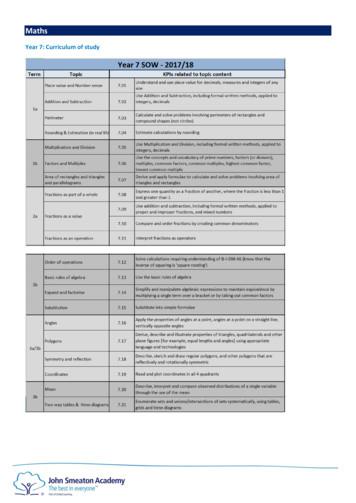Secondary Maths Guidance
CENTURY for Secondary MathsIntroductionThe beauty of CENTURY is that it is powered by students. If your students are using it, theyare learning. If your students are learning, they are producing insightful data for you and yourteam to analyse and act upon. The only thing you need to do is to ensure the relevant mathscourses have been assigned to your classes.The following document has been created to assist you when you are ready to takemore control of the platform and to guide you on how to embed CENTURY into yourdepartment.Table of ContentsYear 7 Catch Up . 2Schemes of work . 2Making the most of data . 3Interventions. 4CENTURY Mathematics Courses . 5Tips for maximising use of CENTURY . 7
Year 7 Catch UpAssessing the gaps in knowledge of your new cohort is now more important than ever. Onceyou’ve assigned the Mathematics - Secondary - Foundation course, you could decide to takeone of these approaches:1. Set all three diagnostics through the Planner (Essential Four Operations, Catch Up orSecondary Ready) to gain an overview of learners’ gaps in knowledge.2. Set the Secondary Ready diagnostic through the Planner to identify whether studentsneed to be set the, more accessible, Essential Four Operations and Catch Updiagnostics.The attached document provides a question breakdown of the above diagnostics in thiscourse.Schemes of workSetting Diagnostics (using the Planner)CENTURY’s Secondary - Higher Maths coursehas almost 1000 nuggets. Teachers may want todirect their students to appropriate areas of thecourse by using the Planner to set a diagnostic.This is especially relevant to students who arejoining CENTURY later in KS3 or in KS4.Once a particular diagnostic has been set,CENTURY will be able to make personalisedsuggestions on topics that are relevant to thework students will be doing in class.The attached document gives the question levelbreakdown of each diagnostic.Setting Nuggets (using the Planner)Another way to ensure students are recommended nuggets on CENTURY which are relevantto their classwork is by setting individual nuggets. All of CENTURY’s learning material is linkedto pre-requisites and nuggets to extend their learning. When setting nuggets to align to ascheme of work we suggest setting no more than three nuggets at a time. This is becausethey take priority in the path. By setting no more than three nuggets, students can still accessnuggets set by the recommendation engine.For example, if students are set the nugget Algebraic Fractions 1: Simplify [MH54.01], anymistakes will be recognised by the system. Students will then be recommended nuggetsbased on their gaps in knowledge, such as Factorising 2 [MF18.08], Multiplying Fractions 2[MF4.24]. Additionally, if a student completes a nugget and shows they have a goodunderstanding, they will be recommended more complex nuggets within that topic to providestretch and challenge.
Department-wide Consistency (using the Planner)By appointing a CENTURY champion in your Mathematicsdepartment, you can ensure consistency throughout eachyear group. Using diagnostics and/or nuggets to map outthe curriculum, these plans can then be imported by otherteachers to their classes. This saves teacher time andensures all students will be recommended CENTURYcontent related to your scheme of work.Making the most of dataClass Admin to see Year Group Data / Set classesAs well as seeing the results of an individual class, HODs may view the data of a whole yeargroup. Using Class Admin, it is possible to assign a course to an entire year group and thenuse the Teacher Dashboard to see results across the year. Be mindful if students are ondifferent tiers of the secondary maths course as assigning the course to the year group willgrant all students access.Once students are in the appropriate year/course class, HODs may decide to use the Nuggettab within the Teacher Dashboard to see a question level analysis of each diagnostic ornugget. This information will inform any adaptations to schemes of work according to theprior knowledge of each year group.Using Diagnostics to evidence progressDiagnostics can be used at the beginning of a topic within a scheme of work to highlight toHODs/teachers any gaps in knowledge within the group.This data can be exported to an Excel spreadsheet and used as a ‘pre-test’. CENTURY willonly set each diagnostic once to find gaps in knowledge, however the teacher has the abilityto reset the diagnostic using the Planner.Setting this diagnostic at the end of the topic acts as a ‘post-test’ and can again be exportedfrom the Markbook to evidence progress.Note: When exporting data from the ‘post-test’, it is important to use the time stamp on themarkbook to ensure the data collected is from the students’ second attempt.In order to know which diagnostic is most appropriate for upper KS3 and KS4 learners, take alook at our Maths Diagnostic Mapping.
InterventionsIntervention GroupsUsing Class Admin, intervention teachers or learning support assistants can create classes forintervention groups to analyse data and evidence progress using the Markbook.Note: It is important to create intervention classes based on the course students areassigned. Also make sure to assign the relevant course to the class in order to view thedata.Flipped LearningSetting nuggets for flipped learning allows teachers to focus on the most important areas ofimprovement for their class. Being able to gain an understanding of students’ levels ofknowledge of coordinates by setting a CENTURY nugget in advance will enable teachers toplan a tailored lesson on graphs without wasting valuable lesson time checking priorknowledge.Assessment for LearningUsing nuggets for AfL tasks in class provides students with immediate feedback and teacherswith instant data on their progress. These data insights enable targeted interventions, whilstthe data dashboard highlights the precise areas students need help with.CENTURY’s recommendation engine will set completely personalised homework for eachstudent and track their engagement and performance through the Teacher Dashboard.
CENTURY Mathematics CoursesWhen you subscribe to CENTURY, you have access to all our courses, which are listed below.Any new maths courses published in the future will also be automatically added to youraccounts.Primary CoursesCourseAppropriate forNotesPrimary Mathematics - Year 3Year 3in line with National CurriculumContains pre-requisite nuggets fromYear 2Primary Mathematics - Year 4Year 4in line with National CurriculumContains pre-requisite nuggets fromYear 3Primary Mathematics - Year 5Year 5in line with National CurriculumContains pre-requisite nuggets fromYear 4Primary Mathematics - Year 6Year 6in line with National CurriculumContains pre-requisite nuggets fromYear 5Primary Mathematics - ArithmeticYear 6KS3 Students with low arithmetic skills.Arithmetic PracticePrimary Mathematics - MultiplicationTablesYear 6KS3 Students with low times tablesknowledge.Multiplication Tables Practice11 CoursesCourseExamBoardAppropriate forNotes11 MathematicsGL andCEMStudents sitting the11 Content extends beyond KS211 Non-VerbalReasoningGL andCEMStudents sitting the11 KS3 critical thinkingContains problem solving questions which promotecritical thinking.Secondary CoursesCourseExamBoardAppropriate forNotesSecondary Foundation AllYear 7s joining theschoolFoundation course with additional diagnostics andprerequisites to ensure new Year 7s are ready forsecondary mathematics. Foundation data will move withthe student if moved to the Higher course.Secondary FoundationAllKS3 Students and KS4students sitting theFoundation GCSE paperSubset of Higher course.Foundation data will move with the student if moved tothe Higher course.Secondary HigherAllAny student expected tosit the Higher GCSEpaper.Course contains the full Foundation course. Foundationdata will move with the student if moved to the Highercourse.
Bridge to AlevelAllFE GCSE FoundationAllStudents who areworking at a level 7-9and need to bechallenged.Essential grounding forstudents moving onto ALevel maths.Covers key basic content of A-Level maths course atGCSE level, includes some content beyond the GCSEsyllabus (e.g. differentiation).Adapted from Secondary - Foundation course. Fewerdiagnostics (calculator & non-calculator)IGCSE CoursesCoursesExam BoardNotesIGCSE (Edexcel) - CoreEdexcelSubset of Extended course.Core data will move with the student if moved to the Extendedcourse.IGCSE (Edexcel) - ExtendedEdexcelCourse contains the full Core course. Core data will move withthe student if moved between Core/ Extended courses.IGCSE (Cambridge) - CoreCambridgeSubset of Extended course.Core data will move with the student if moved to the Extendedcourse.IGCSE (Cambridge) - ExtendedCambridgeCourse contains the full Core course. Core data will move withthe student if moved between Core/ Extended courses.Functional Skills CoursesCourseExam BoardNotesFunctional Skills - Entry Level1C&G, Edexcel, OCRMay be helpful in terms of terminology for EALstudents.Functional Skills - Entry Level2C&G, Edexcel, OCRMay be helpful in terms of terminology for EALstudents.Functional Skills - Entry Level3C&G, Edexcel, OCRMay be helpful in terms of terminology for EALstudents.Functional Skills - Level 1C&G, AQA, Edexcel,OCRFunctional Skills - Level 2C&G, AQA, Edexcel,OCR
Tips for maximising use of CENTURYFast track your studentsStudents with a good mathematical understanding will quickly progress to the areas of thecourse that will challenge them. If you want to speed up this process, the attached documentgives the question level breakdown of each diagnostic. Set the diagnostic(s) that align to thetopics your students are working on. This allows CENTURY to make personalised suggestionson topics that are relevant to the work students will be doing in class.Setting individual nuggets through the Planner that are aligned to your scheme of workenables CENTURY to make recommendations linked to the precise nuggets you choose.CENTURY will react to fill any gaps in prerequisite knowledge and stretch learners thatalready have a good understanding. Departments using this approach should aim to setaround 3 nuggets per week as a maximum.Data Insights for entire cohorts *Using Class Admin to create a course class enables data insights across the year group andallows work to be set en masse for an entire cohort of learners. Using the tools in the TeacherDashboard can provide detailed insights into engagement, attainment and specific areas ofstrength and weakness for an entire cohort.Evidencing progress †Student data can be time stamped and exported to Excel from the Teacher DashboardMarkbook. Setting diagnostics as an initial assessment and then as progress checksthroughout the year can help highlight the progress students have made.Interventions ‡Using class admin to create intervention groups equips teachers with all the tools to focus onkey cohorts of learners of any size.Using CENTURY for interventions Setting nuggets for flipped learning allows teachers to focus on the most importantareas that they need to teach their class. Using nuggets for AfL tasks in class provides teachers with instant data. CENTURY’s recommendation engine will set completely personalised homework foreach student and track their engagement and performance through the TeacherDashboard.The data insights generated through the dashboard enable targeted intervention, highlightingthe precise areas students need help with.* Create classes based on the course students are assigned. E.g. foundation tier learners in afoundation tier class, higher tier learners in a higher tier class.† The Markbook shows the students’ most recent attempts. See attempts at any point in time by timestamping the markbook.‡ Create intervention groups based on the course students are assigned.
Level maths. Covers key basic content of A-Level maths course at GCSE level, includes some content beyond the GCSE syllabus (e.g. differentiation). FE GCSE - Foundation All Adapted from Secondary - Foundation course. Fewer diagnostics (calculator & non-calculator) IGCSE Courses Courses Exam Board Notes IGCSE (Edexce
SAU PhD Maths Questions Papers Contents: SAU PhD Maths Que. Paper-2014 SAU PhD Maths Que. Paper-2015 SAU PhD Maths Que. Paper-2016 SAU PhD Maths Que. Paper-2017 SAU PhD Maths Que. Paper-2018 SAU PhD Maths
Year 7 & 8 Numeracy Workbook. Week Topic AFL 1 Addition 2 Subtraction 3 Mental Maths 4 Multiplication 5 Division 6 Mental Maths 7 BIDMAS 8 Percentages 9 Mental Maths 10 Simplifying Fractions 11 Adding Fractions 12 Mental Maths 13 Fractions-Decimals-Percentages 14 Ratio 15 Mental Maths 16 Collecting Like terms 17 Substitution 18 Vocabulary and Directed Numbers 19 Word Based Puzzle. Week 1 Maths .
PRIMARY MATHS SERIES SCHEME OF WORK – YEAR 6 This scheme of work is taken from the Maths — No Problem! Primary Maths Series, which is fully aligned with the 2014 English national curriculum for maths. It outlines the content and topic order of the series and indicates the level of depth needed to teach maths for mastery.
maths indu art indu tue eng indu hindi indu maths indu music indu wed eng indu hindi indu maths indu art indu thu eng indu hindi indu maths indu ls indu fri eng indu hindi indu comp rupam maths indu sat eng indu hindi indu maths indu music indu d.a.v public school, sasaram online class time-table d.a.v public school, sasaram online class time .
Maths ‘After Maths’– KS3 students Miss Cahill Y16 3-4pm Maths After School Mentoring Club - Year 8.9.10 (29 Sept 15 to 22 Oct 15 inclusive) Maths Department LRC 3-3.45pm Maths Revision – Year 11 R-Band GCSE Maths
new new Contents new edition B E A M new APEX MATHS 4–7 CAMBRIDGE MATHS 8–19 DIRECT ACTIVITY AND RESOURCE BOOKS 20–23 20 Talking Points 20 Numbers 21 Playing with Numbers 21 Puzzles, Mazes and Numbers 21 Seven Dizzy Dragons 22 Cambridge Number Rhymes 22 Mathswords 22 Cambridge Maths Assessment CD-ROMs 23 Mental Maths 23 Home Maths 23 INDEX 24
maths. Below is a list of maths equipment required every maths lesson, and the reasons why they need it: RED PEN – When students are taking key notes in maths, or copying model answers from the teacher, they must use a red pen. WHITEBOARD PEN – During maths lessons, studen
Social Science In, Gr, L, A Languages, Hist, BusStud, Life Science, Geog, Consumers, CAT, Maths Lit or Maths BA Language Any Management Science B, Nu, Gr Maths Lit or Maths, Account, Econ, BusStud, CAT BComm, BRek, Nas Dip in Business Studies Maths 60% (Univ), Maths Lit (College), R























